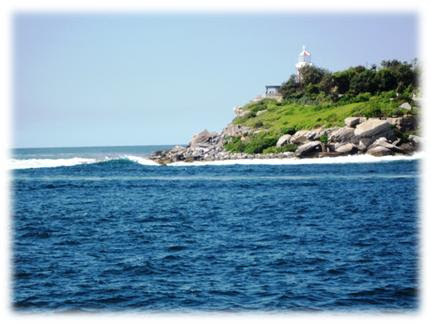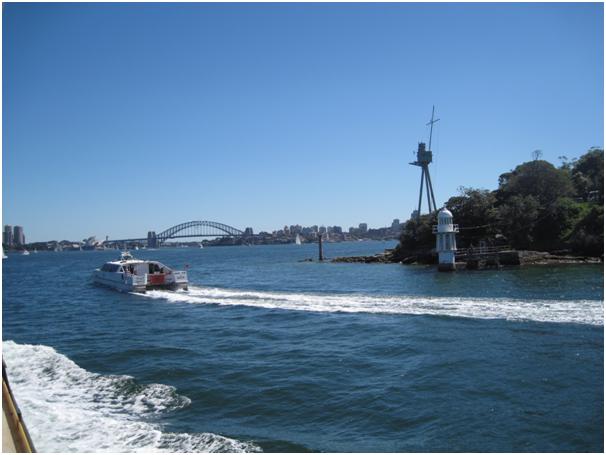I am at one with the poet John Masefield whenever I visit Sydney, for I too must go down to the sea again. But it is not the lonely sea and the sky for which I yearn, quite the opposite actually. I yearn for the closeness of the sea’s watery fingers, gently rubbing the 240 kilometres of shoreline which makes Sydney Harbour one of the most beautiful natural harbors in the world. It is the very closeness of the land, with its houses dotted like pickets in a thicket, which give it an intimacy unlike no other. Vancouver and San Francisco come close, but Sydney takes the biscuit.
The beauty of Sydney Harbour is that it is so reachable. Millions have strolled along the edges at Circular Quay, from where the ferries leave for their intriguing destinations, taking in the quintessential Sydney views of the Opera House and the Harbour Bridge. But as so much of Sydney Harbour’s foreshores are coated in great swards of bush-land, with walking paths leading to thin scimitar beaches, or over wind scoured sandstone cliffs, it is easy to do a cost-nothing-but-energy amble, with only the shore break and the screech of parrots for company. But oh what a restive backdrop! A modern city skyline, sometimes looking as though rising from the ancient bush itself, and a busy harbor full of boats, sleek and stubby yachts and majestic ocean liners.

Sydney Harbour Bridge and the Manly ferry, from Circular Quay
But if your stay is short, you have had your fill of the thrum of the city, or like Masefield, you yearn for the flung spray and the blown spume, and the seagulls crying, simply board a ferry and go where it takes you. One cannot fail to feel shoulders fall, eyes take rest and the whole body just relax as the joys of a ferry journey wash over, as though on a romantic cruise. It is a short sea journey to which you treat yourself, to destinations with doughty British names like Drummoyne, Balmain and Rose Bay, or the more curiously tongued Kiribilli, Taronga or Parramatta, reflecting the centuries of Aboriginal association with the land. But if it is an ‘ocean voyage’ you yearn, take the Manly Ferry across the ‘Heads,’ the outlet of Sydney Harbour to the sea, and then it is easy to see why the old pre-metric ferry slogan of Seven miles from Sydney, a thousand miles from care, still has resonance.
The Manly ferries are sturdy craft with a point at each end, a design not much changed from the early 1920s when three were purpose built for the Manly run and joined by similar number from Scotland. The current fleet is just over 20 years old, but constantly upgraded and refurbished, robust and sturdy, with the tang of the sea salt about them, and the occasional waft of hot dogs from the galley. Roughly a thousand tons for a thousand passengers, with thumping diesels to push through broad waters of the harbor and on occasions, butt through the combers and swell which have rolled across the Pacific and fling their last wave through the harbor Heads. In the mornings, they carry cadaverous and corpulent commuters to the city centre of Sydney, and then home again in the evening. But in-between, it is surfers, sunbakers and sloths, to sport themselves on the magnificent Manly Beach, to watch the world from seats along a promenade of Norfolk Island pines, and scoff fish and chips when hunger calls.

The Opera House, sails and distant sails.
The journey provides a collage of perfect picture postcard perspectives of the iconic, for the Opera House is at the entrance to Circular Quay, as well as Kiribilli House, the when-in-Sydney residence of the Australian Prime Minister, and the 1840’s colonial Italianate sandstone mansion, Admiralty House, now the residence of the Governor-General, when in Sydney. Then, Fort Denison glides by, once a bare rock island on which recalcitrant convicts were left in irons, with just bread and water (The island, is still known by the old convict term Pinchgut, well before the days of Jenny Craig!). Fear of a possible American attack in 1839, meant a start of construction of the Martello Tower fort, the last such structure built in the British Empire. It was finally completed in 1855 following fears of a Russian attack on Sydney, but the system of cannon was already obsolete at its completion. Ironically the only hits ever taken by Fort Denison were ‘friendly fire’ from the cruiser USS Chicago firing her 5” shells at a Japanese midget submarine. After that, property prices around the harbor were cheap as chips!

Past Fort Dennison (Pinchgut) with its Martello Tower
The waters widen, with Taronga Park zoo, with its superb views back to the city, and the enveloping Sydney Harbour National Park bush land on one side hugging the northern shore. On the other, the houses, apartments, and yacht anchorages below Potts Point (The Australian Navy fleet is headquartered at Garden Island), Rushcutters Bay and Rose Bay, blend in beautifully with the trees. Once, those great lumbering albatross-like flying boats, and the more graceful Catalinas, of Qantas Imperial Airlines, used to land at Rose Bay, and the whole harbor seemed to stop to watch. Now it is only little tourist ‘dragonfly’ planes that kiss the deep blue waters.

The Southern harbor foreshore with yachts in the garden!
In the 19th and 20th centuries, fortifications were established around much of the harbor and the area around Middle Harbour remains honeycombed with tunnels. The military have now given much of the land back to the Australian Government, which has turned it into parkland. In WWII, huge boom nets across an area near the harbor entrance, couldn’t stop three Japanese midget submarines penetrating the defences and while the death toll inflicted was relatively slight, it engendered enormous panic in Sydney

South Head and beyond, the Pacific Ocean
Even on calm days, with an oily swell, the Manly ferry does a bit of rocking and rolling as it passes by the Heads. When the wind is like a whetted knife, (If I can sail once more with Masefield!) and the tempest comes, even large ships hip-hop, and the spray flares over each bow like a bomb burst. Everyone hangs on, adults wheeze, kiddies shriek, and the Manly ferry buries her head into even the biggest waves, like a forward into a scrum only to rise like a jumper in the line-out. Traffic on the harbor thins, and the pleasure craft stay moored, yachts ride in their pens with their sails furled, and the Manly ferry hurries for the lee of North Head, and the old Quarantine Station. The shelter of Manly Cove is but minutes away, and so is the end of the journey. Thirty minutes has passed.

Sitting on a sailboat off Balmoral Beach in Middle Harbour
The ferry ride has changed little over the last forty years, from when I first took my first journey from care. Although the $14 return fare is now a darn side more expensive, it is still worth every cent! Where else can you do such a magnificent cruise so cheaply, and come back so refreshed and rejuvenated of spirit? There are some locations and experiences that are just well worth the money, and the Manly ferry is one of them. And part of the joy of travelling to Manly on a return ticket, is knowing that you still that you have the homeward journey from Manly to enjoy. It’s a whole new perspective, with even the sight of a different shore. Sure, there is a faster jet boat, but why would you want to hurry on a journey such as this.

Passed by a fast ferry at Bradley’s Head. The fighting mast of the WWI cruiser, HMAS Sydney stands as a memorial to all who have perished at sea.
And I always step ashore again in Sydney, with a little twinge of sadness that my sailing is over for the day, I am, at the same time enormously gladdened that I have made the voyage. Ah yes, as in Masefield’s Sea Fever, I too could be lured, to the vagrant gypsy life, if all sea journeys were as scenic, or as enjoyable, as a trip on the Manly Ferry.
Winfred Peppinck is the Tales of the Traveling Editor for Wandering Educators
All photos courtesy and copyright Winfred Peppinck
